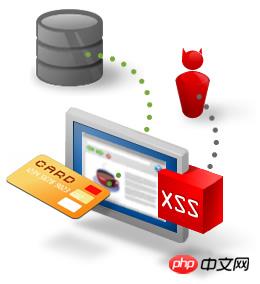 Web Front-end
Web Front-end
 H5 Tutorial
H5 Tutorial
 The final chapter of detailed analysis of HTML5 security attacks and defenses: HTML5's security improvements
The final chapter of detailed analysis of HTML5 security attacks and defenses: HTML5's security improvements
The final chapter of detailed analysis of HTML5 security attacks and defenses: HTML5's security improvements
Please indicate the source when reprinting: The final chapter of the detailed analysis of HTML5 security attack and defense: HTML5’s security improvements
HTML5 makes a lot of additions to the old security strategies.
1. iframe sandbox
HTML5 adds a sandbox attribute to the iframe element to prevent untrusted web pages from performing certain operations, such as accessing the DOM of the parent page, executing scripts, accessing local storage or local databases, etc. But this security strategy will bring other risks, which is very interesting. For example, ClickJacking attacks prevent JavaScript scripts from running to bypass JavaScript defense methods.
2. CSP content security policy
XSS bypasses the same-origin policy through fake content and clickbaiting. The core of the XSS attack is that the browser cannot distinguish whether the script is injected by a third party or is actually part of your application. CSP defines the Content-Security-Policy HTTP header to allow you to create a whitelist of trusted sources so that the browser only executes and renders resources from these sources, rather than blindly trusting all content provided by the server. Even if an attacker can find a vulnerability to inject a script, it will not be executed because the source is not included in the whitelist.

The principle of XSS attack
3. XSS filter
Modern browsers such as Chrome and Safari have also built security defense measures and provide XSS filters on the front end. For example, http://www.php.cn/;/p><script>alert(1)</script> will not be executed in Chrome, as shown in the figure below.

4. Others
In addition, HTML5 applications are more restricted in accessing system resources than Flash.
Finally, the HTML5-specific security specifications are still under discussion. Some people want to spread them into various chapters of the HTML5 specifications, and some people want to list them separately. There is currently no separate content, because not only the security of Web App developers must be considered , we should also consider the vendors that implement HTML5 support and standardize and guide them.
I personally think that the security specifications of HTML5 will be explained in a unified chapter and mentioned accordingly in each functional module.
The above is the final chapter of the detailed analysis of HTML5 security attacks and defenses: HTML5’s security improvements. For more related content, please pay attention to the PHP Chinese website (www.php.cn)!

Hot AI Tools

Undresser.AI Undress
AI-powered app for creating realistic nude photos

AI Clothes Remover
Online AI tool for removing clothes from photos.

Undress AI Tool
Undress images for free

Clothoff.io
AI clothes remover

AI Hentai Generator
Generate AI Hentai for free.

Hot Article

Hot Tools

Notepad++7.3.1
Easy-to-use and free code editor

SublimeText3 Chinese version
Chinese version, very easy to use

Zend Studio 13.0.1
Powerful PHP integrated development environment

Dreamweaver CS6
Visual web development tools

SublimeText3 Mac version
God-level code editing software (SublimeText3)

Hot Topics
 1385
1385
 52
52
 Table Border in HTML
Sep 04, 2024 pm 04:49 PM
Table Border in HTML
Sep 04, 2024 pm 04:49 PM
Guide to Table Border in HTML. Here we discuss multiple ways for defining table-border with examples of the Table Border in HTML.
 HTML margin-left
Sep 04, 2024 pm 04:48 PM
HTML margin-left
Sep 04, 2024 pm 04:48 PM
Guide to HTML margin-left. Here we discuss a brief overview on HTML margin-left and its Examples along with its Code Implementation.
 Nested Table in HTML
Sep 04, 2024 pm 04:49 PM
Nested Table in HTML
Sep 04, 2024 pm 04:49 PM
This is a guide to Nested Table in HTML. Here we discuss how to create a table within the table along with the respective examples.
 HTML Table Layout
Sep 04, 2024 pm 04:54 PM
HTML Table Layout
Sep 04, 2024 pm 04:54 PM
Guide to HTML Table Layout. Here we discuss the Values of HTML Table Layout along with the examples and outputs n detail.
 HTML Input Placeholder
Sep 04, 2024 pm 04:54 PM
HTML Input Placeholder
Sep 04, 2024 pm 04:54 PM
Guide to HTML Input Placeholder. Here we discuss the Examples of HTML Input Placeholder along with the codes and outputs.
 HTML Ordered List
Sep 04, 2024 pm 04:43 PM
HTML Ordered List
Sep 04, 2024 pm 04:43 PM
Guide to the HTML Ordered List. Here we also discuss introduction of HTML Ordered list and types along with their example respectively
 Moving Text in HTML
Sep 04, 2024 pm 04:45 PM
Moving Text in HTML
Sep 04, 2024 pm 04:45 PM
Guide to Moving Text in HTML. Here we discuss an introduction, how marquee tag work with syntax and examples to implement.
 HTML onclick Button
Sep 04, 2024 pm 04:49 PM
HTML onclick Button
Sep 04, 2024 pm 04:49 PM
Guide to HTML onclick Button. Here we discuss their introduction, working, examples and onclick Event in various events respectively.



